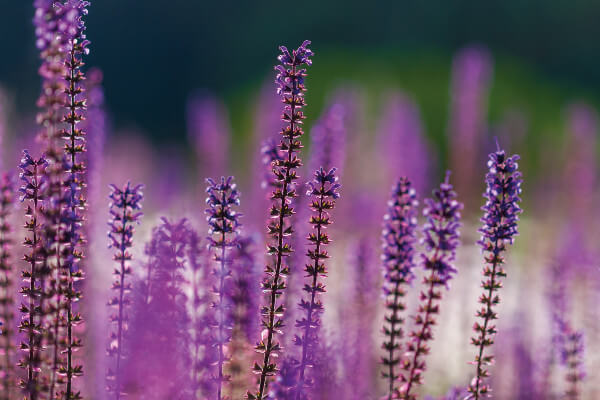Gardens that can Stand the Heat

With global temperatures on the rise and all of us trying to cut down on our water usage, choosing drought-tolerant plants for your garden is more important than ever…
Three to Take Home
Helen Reeley, of Berkhamsted-based Reeley Gardens, shares her three favourite drought-resistant plants with us. She says: ‘They’re bullet proof, a good size and, once established, will take all the sun, so drought-tolerant. They won’t thrive in a shady position so south to south west is best.’
- Perovskia ‘Blue Spire’ – a very delicate, romantic upright silver blue perennial that grows to 50cm.
Common name Russian sage. - Salvia nemorosa ‘Caradonna’ – has green foliage with purple flowers. Grows to 50cm. Common name Salvia (pictured).
- Hylotelephium ‘Matrona’ – fleshy pale green and purple leaves with pink flowers. Grows to 50cm. Common name Sedum or Stonecrop.
2020 proved to be the hottest year in Europe since records began, according to the European Union’s Copernicus Climate Change Service. It also tied with 2016 as the hottest year worldwide.
So what does that mean for our green and pleasant land? Lawns as we know them could be one of the casualties, as any keen gardener will know the sadness of a brown, scorched lawn after a long hot summer. However, if you leave your grass longer, or even transform it into a wildflower meadow, your lawn will be more resistant to weather change. Allowing more growth on top makes for longer roots under the surface – which can search out more moisture.
Mediterranean-type plants are bred to survive long hot summers, and they can do well in English gardens too. They don’t need constant watering either, which is great for properties on a water meter – or lazy gardeners! However, one thing to consider is that the change in climate, while resulting in longer, hotter summers, may also see wetter winters – and Mediterranean plants are not so happy in the wet!
It’s not just about plants
Cultivating your soil is also key to encouraging water retention. You can dig in organic matter such as composted bark, garden compost and farmyard manure (as long as it is well rotted). Even used coffee grounds are good for water retention. A mulch applied above ground will also help to prevent water evaporating from the soil in the heat.
Applying the correct amount of fertiliser is also important. This enables plants to use water efficiently. Too much and they will put on too much green growth, and need extra watering.
Plant windbreaks to stop wind evaporation of water from the soil. And remember to find space for water butts so you are not using tap water.
Which plants to choose?
In addition to Helen’s suggestions above, look for plants that have silver or grey-green leaves. These reflect the sun and so help to retain moisture. Also choose plants according to where you are going to plant them – if they like semi shade, don’t plant in full sun where they will become thirsty.
Some plants to choose:
- Ceanothus with its stunning blue flowers is a great choice for maximum impact.
- Hebe ‘Margret’ has a compact, rounded shape and delicate light blue flowers in early summer.
- Hebe albicans is an evergreen dwarf shrub with dense spikes of white flowers.
- Don’t forget bulbs! Allium sphaerocephalon sports unusual egg-shaped flowers, and tall Allium ‘Ambassador’ boasts perfectly spherical heads of purple flowers.
- Grasses look great in gravel gardens. We love Miscanthus sinensis ‘Kleine Fontäne’ with its feathery flower heads that turn from red to silver in late summer/autumn.
Looking after your plants
- Water plants well when planting and mulch around them.
- Choose younger, smaller plants that will adapt to their new conditions more easily.
- Mediterranean plants should ideally be planted in spring and early summer when the soil has warmed up. If you plant in autumn they will soon become unhappy in cold, damp soil.
- Weed regularly to cut down the competition.
Make a gravel garden
Gravel gardens are ideal for drought-tolerant planting schemes and perfect for gravelly or sandy soil. They’re also low maintenance. To create a gravel garden, choose a sunny area of your garden and lay landscape fabric or weed suppressant over the ground before planting – this will help to keep weeds at bay. Cut crosses in the fabric where you want to plant your chosen plants. Use whatever gravel you like – limestone chippings can affect the soil quality so best to avoid them, and if you have lots of cats visiting your garden, choose a larger gravel that doesn’t remind them of the litter tray!
